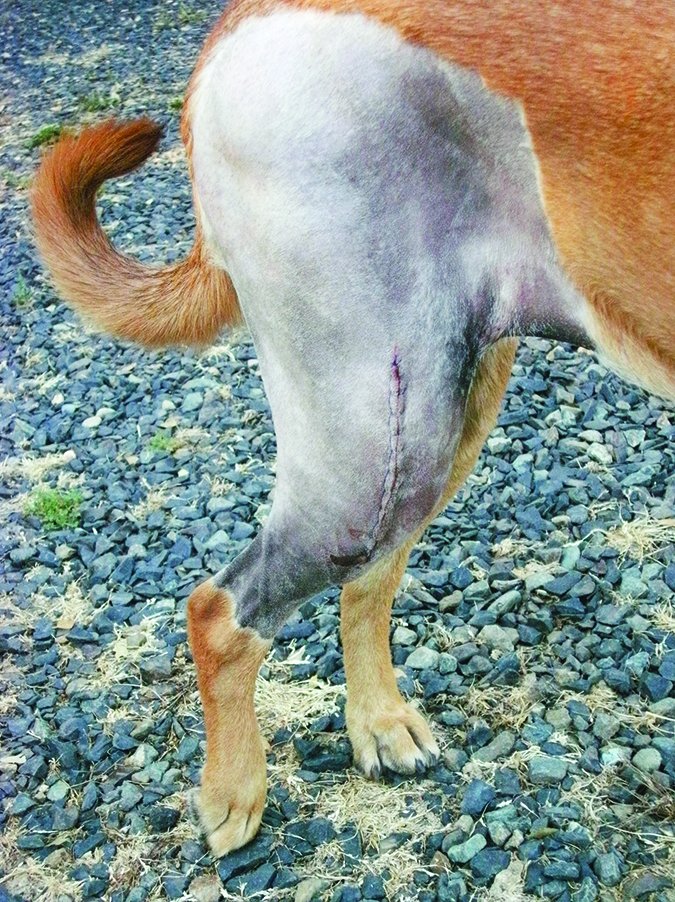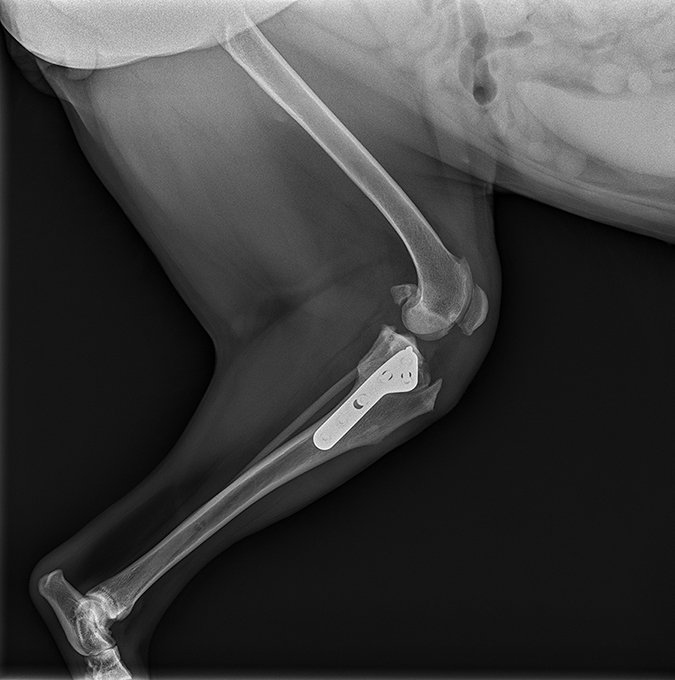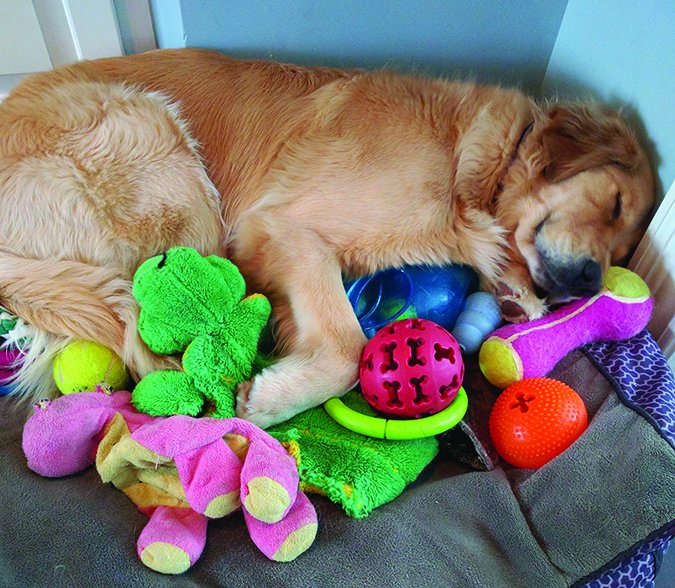When your dog comes in limping from a play session, a lot of thoughts go through your head. Is a trip to the vet needed? What can I give to help? How did this happen?!
Last month, we covered one of the most common orthopedic injuries in dogs – the cranial cruciate ligament tear. This month, we’re going to talk about how to fix it.
The 4 Most Common Options for Treating Dogs’ Cruciate Ligaments
The most common options discussed after the diagnosis of a cruciate ligament tear are:
- Braces
- Lateral suture
- Tibial plateau leveling osteotomy (TPLO surgery)
- Tibial tuberosity advancement (TTA surgery)
There are other procedures out there, but there’s a reason these are the four most common treatments offered.

The truth is, we do not have a perfect solution. Research is constantly evolving and we are still in search of the perfect fix. In humans, a synthetic or biologic ligament is placed where the damaged ligament used to sit. This was tried in dogs, but the outcomes were never good. The replacement ligaments were just not well tolerated. Consequently, something different had to be done.
Braces for Ligament Injuries
Bracing the stifle is no small task. It’s an incredibly dynamic joint that provides spring, shock absorption, and the ability to turn on a dime. The key to a brace is stability and fit.
Braces for a cruciate tear may cost $1,000 or more. There are inexpensive options, but bargains are not a great idea when it comes to your dog’s lifelong comfort.
Ideally, a knee brace is custom-fit for your dog, sometimes involving a mold made of his joint. This ensures good fit and appropriate flex. Remember, the knee still needs to bend to be useful! A brace cannot provide complete stability, but it can alleviate some of the pain from a joint that is moving improperly.
The two canine-brace companies most often recommended by vets are OrthoPets and Hero Braces. It’s important to remember that a brace does not fix a cruciate tear, it simply helps to stabilize the knee. Success depends on selecting the right brace, a good physical therapy program, and a commitment to refitting as needed.
The Lateral Suture Procedure
The lateral suture procedure (also known as the extracapsular repair) is the closest thing to the repair done in humans. This does not make it the best choice. This is one of the first surgeries developed when it was determined that repairing the ligament directly was not a good option.
In this procedure, a heavy gauge suture is placed outside of the knee joint in the same direction that the cranial cruciate ligament used to run. A hole is drilled through the front of the tibia (the lower leg bone). The suture is passed through this hole and then up and around a small bone, called a fabella, behind the femur (the upper leg bone). The creates a loop that is similar in location and direction to the cranial cruciate ligament, but outside of the joint.
This is an important distinction. Because this surgery does not involve opening the joint, the meniscus (the cartilage cushion that provides shock absorption in a joint) is not always evaluated for tears. The jury’s still out on this procedure, but most surgeons feel a torn meniscus can cause persistent pain.
Ultimately, the goal of this surgery is not to repair the cruciate ligament, but rather to direct the growth of scar tissue. Basically, the suture provides a scaffold for scar tissue to form along the same path as the torn cruciate ligament, thereby stabilizing the joint. Over time, this suture will break down. It’s not meant to last forever, just long enough for enough scar tissue to form.
This procedure is quick, relatively inexpensive (typically $1,500 to $2,000) compared to other surgical repairs, and can often be performed by your regular veterinarian. However, it’s not for every case.
If the suture breaks before sufficient scar tissue is laid down to stabilize the joint, the entire surgery becomes ineffective. If a dog is too big or too active, you can almost guarantee failure. Most veterinarians recommend this surgery only for dogs who are less than 40 pounds or dogs who are happy being couch potatoes. Having said that, finances are an important part of any veterinary decision, and this is definitely the least expensive surgical option.

TPLO and TTA Surgery
The tibial plateau leveling osteotomy (TPLO) and the tibial tuberosity advancement (TTA) procedures are both aimed at mechanically altering the joint to make the cranial cruciate ligament unnecessary. Both surgeries require the surgeon to open the joint, so the meniscus can be evaluated for tears. These are somewhat complicated surgeries and involve a complex understanding of the knee joint, but we’ll cover the basics.
In last month’s article, I described the structure of the canine stifle joint and how it differs from the human knee. The slope to the tibia is one of the biggest contributing factors to this injury. In the TPLO surgery, this slope is taken out of play. A circular cut is made in the top of the tibia and the slope is rotated into a neutral position. A plate is used to secure the bone in its new position. This creates a knee joint that closely resembles the human knee joint. Without that slope, the cranial cruciate ligament is no longer as important; the knee is stable without it. This surgery is typically performed only by boarded surgeons and costs around $4,000.
This procedure has the fastest reported return to normal activity, meaning dogs who get this surgery are able to return to a comfortable life faster than any other procedure out there. However, it’s not without drawbacks.
Aside from the cost, there is risk of failure. When a dog is too active immediately after surgery, the plate can break or move. Failure of the plate can be catastrophic. Recovery is an eight-week process, involving first crate rest, then physical therapy, and a gradual increase back to running in the yard.
Similar to the TPLO, the TTA changes the forces in the knee joint to render the cranial cruciate ligament unnecessary. In this case, a cut is made in the front of the tibia. This piece of bone is moved forward, which pulls on the patellar tendon and neutralizes the backward motion of the femur during weightbearing. This lets the dog move comfortably without an intact cruciate ligament.
In this case, a specialized device consisting of a “cage” and a “fork” is used to secure the bone in its new position. Over time, it heals fully and is very stable. If it were to fail, a TPLO procedure can still be performed.

The recovery time for these two surgeries is similar, but dogs typically take a little longer to be fully comfortable after the TTA surgery. The cost is a bit less than a TPLO, but it is also an expensive procedure – usually in the $3,000 to $3,500 range. It is typically performed only by boarded surgeons, but there are some general practitioners who are comfortable with it and have the necessary equipment.
Don’t Self-Medicate
When your dog hurts, you may tempted to look in the medicine cabinet for something to ease her pain. But there are very few over-the-counter human medications that you can safely give your dog.
Many years ago, we used aspirin for pain in dogs. However, studies have shown that the pain control offered by aspirin is pretty minimal and it has serious side effects. Aspirin increases bleeding tendencies by inhibiting platelets, a key component in clotting blood. Aspirin use also limits the options that your vet has to treat your dog’s pain because of how it interacts with other medications.
Ibuprofen should never be given to dogs as it can cause irreversible liver damage and can even be fatal. Tylenol (acetaminophen) has its place in veterinary medicine, but only under the guidance of a veterinarian because, with certain other diseases, it can be very dangerous.
If your dog is in pain, resist the urge to toss her a human pain-killer. Your veterinarian has an arsenal of medications that are safe for dogs and will work much better than what you have at home.
If Your Puppy Is a Lemon, Make Lemonade!
Shortly after our dog Agnes was born, she was considered the pick of the litter for Paws with a Cause, a local organization that trains service dogs. However, at her very first veterinary appointment at just eight weeks old, she was found to have hip dysplasia and “trick knees” – which, in her case, had her kneecaps slipping to the outside of the joint.
Because of these problems, she couldn’t be a service dog and she couldn’t be adopted to the public. She needed thousands of dollars in surgery to fix her back legs! Euthanasia was being considered for this little “lemon” of a puppy. In a lucky twist of fate, she found her way to our doorstep, just when we were looking for a new companion for our family.
Agnes underwent three major surgeries at just four months old. A local veterinary surgeon offered her services pro bono, using Agnes as a teaching case to learn a new procedure. Agnes’ pelvis and both of her knees needed corrective procedures. Fortunately, her recovery was smooth and she grew into a lovely and beloved dog.
Shortly after she turned three years old, Agnes came up lame after playing with a puppy. Due to her history, we were immediately worried that it was one of her hips, but her limp was intermittent and it didn’t seem painful when her hips were manipulated. It gradually became clear that one of her knees was the problem and she was diagnosed with a partial tear of her left cranial cruciate ligament.
For the next six weeks, Agnes was placed on strict cage rest and a physical therapy program to try to keep her injury from progressing. But three months later, when she was finally allowed to play, she immediately came up three-legged lame; she had torn her ligament completely.
We took her right away to a board-certified surgeon who assessed her knees and we came up with a plan. She underwent a TPLO procedure the very next day to repair her joint yet again. Because of Agnes’ other orthopedic problems, her young age, and her generally wild demeanor, we decided that a TPLO was the best option for a good long-term outcome. This surgery stabilized her joint and decreased her risk of arthritis down the road.
Her rehab seemed far longer than the eight weeks it actually was, especially since she felt comfortable after just a day post-surgery! But the surgery was worth every penny and the rehab was worth every minute of activity restriction. Now, two years later, she’s back to her old antics and shows no sign of lingering discomfort!

Ligament Injury Treatment Conclusions
Again, there is no perfect solution. Every single option is valid for a different circumstance. The important thing is figuring out which solution works for your dog. Older, smaller dogs who are less active often do great with a lateral suture repair! A two-year-old Lab with bad hips needs a bit more stability in the knee, so a plate repair (either the TPLO or TTA) would be a better option.
Your location might make the decision; most surgeons learn one procedure and stick with it, so both might not be offered near you. The two procedures have similar success rates and are both recommended for larger, more active dogs.
Bracing and what’s often referrred to as “conservative management” is simply not as successful as the surgical options, but when surgery is not an option, it’s better than nothing.
With time, the limp from a cruciate tear will improve without any intervention. Scar tissue will form and the joint will be useable, but the arthritis that will develop will limit the dog’s quality of life. This is not an emergency injury, but the sooner it’s addressed, the less arthritis and the better the long-term outcome.
At the risk of sounding like a broken record, talk with your veterinarian! Be up front about financial constraints, recovery concerns, and long-term goals so that you can come up with a plan that’s right for you and your four-legged friend.
Kyle Grusling, DVM, practiced emergency medicine for three years before switching to a general practice, Northland Animal Hospital in Rockford, MI.





